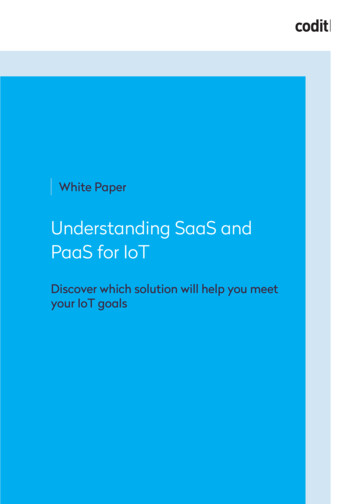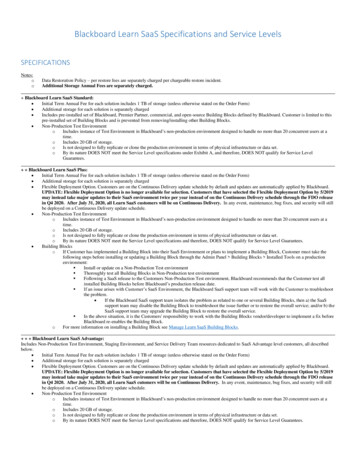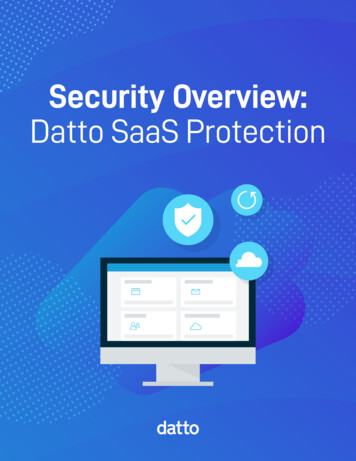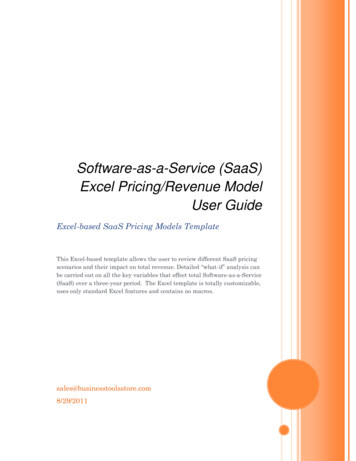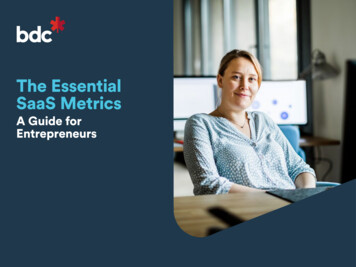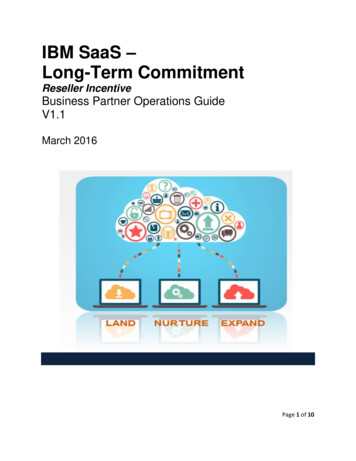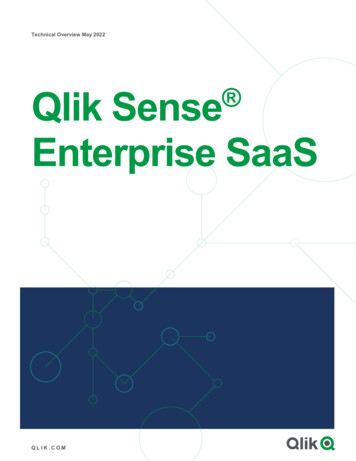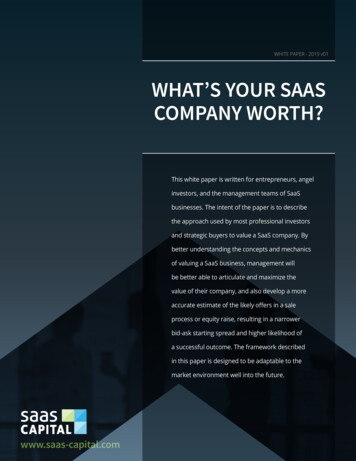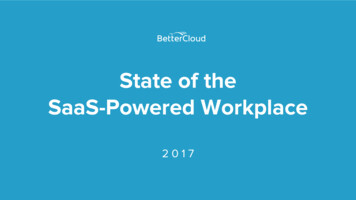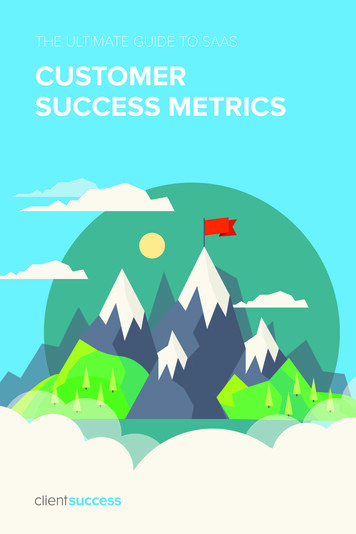
Transcription
THE ULTIMATE GUIDE TO SAASCUSTOMERSUCCESS METRICS
The Ultimate Guide to SaaS Customer Success Metrics2ContentIntroduction . . . . . . . . . . . . . . . . . . . . . . . . . . . . . . . . . . . . . . . . . . . . . . . . 4Top 5 SaaS Customer Financial Metrics . . . . . . . . . . . . . . . . . . . . . . . 6Runner Up Financial Metrics . . . . . . . . . . . . . . . . . . . . . . . . . . . . . . . . 14Top 5 SaaS Customer Health Metrics . . . . . . . . . . . . . . . . . . . . . . . . 20Runner Up Health Metrics . . . . . . . . . . . . . . . . . . . . . . . . . . . . . . . . . . 26Top 5 SaaS Customer Usage Metrics . . . . . . . . . . . . . . . . . . . . . . . . . 32Runner Up Usage Metrics . . . . . . . . . . . . . . . . . . . . . . . . . . . . . . . . . . 38Top 5 Customer Success Team Performance Metrics . . . . . . . . . . . 44Runner Up Team Performance Metrics . . . . . . . . . . . . . . . . . . . . . . . 50How to Use Metrics to Create a Culture of Customer Success . . . 56Brought to You By
THE ULTIMATE GUIDE TO SAASCUSTOMERSUCCESS METRICSBrought to you by ClientSuccessand the 2016 CS100 Summit attendee executives
The Ultimate Guide to SaaS Customer Success Metrics4Dear Reader,In late 2016, the ClientSuccess team hosted the first annual CS100Summit in Park City, Utah where we gathered 100 of the world’smost respected customer success executives and leaders fromtop B2B SaaS companies. This inaugural Summit provided customer success executives an exclusive learning environment withlike-minded leaders in an atmosphere of inspiration, ideation, strategy, and real-world application around customer success.The CS100 participants collaborated on this insightful and high-impact thought leadership eBook called The Ultimate Guide to SaaSCustomer Success Metrics. Consider this their way to give back tothe industry they love.The CS100 attendees shared best practices, recommendations andalignment around 4 key categories of metrics including: SaaS financial metrics, customer success team performance metrics, customerhealth metrics, and product usage metrics. The outcome was a concise list of important metrics customer success leaders should payattention to. Our ClientSuccess team then analyzed the data andsurfaced 10 of the top metrics for each category.This eBook is a compilation of powerful insights and years of bestpractices inspired from those 100 respected customer successleaders. We hope you will use this information a s your go-to guideas you build and scale your customer success team and drive aculture of customer success in your company. We welcome yourfeedback and suggestions as we continue to refine and evolve thiseBook to be the most definitive guide for customer success metrics in our industry. Send feedback to metrics@clientsuccess.comor #csmetrics.All the best,DaveFounder/CEO, ClientSuccessdave@clientsuccess.comBrought to You By
The Ultimate Guide to SaaS Customer Success MetricsThe Ultimate Guide to SaaS Customer Success Metrics55Top 5 SaaSCustomerFinancial MetricsWhen most executives think about customer success metrics, theytypically refer to the core SaaS financial metrics. If current customers are the lifeblood of a SaaS business, then these metrics are theheartbeat metrics for any SaaS company. These financial metricsprovide a top-level view of the overall financial health of an organization and can serve as a strong indicator when it comes to the longterm growth and scalability.Let’s take a look at the top 5 financial metrics, along with the runner-up metrics.Brought to You By
The Ultimate Guide to SaaS Customer Success Metrics61Revenue Retention Rate (Gross & Net)The amount of recurring revenue (ARR/MRR) a company is ableto retain for any given period. Gross Revenue Retention onlyconsiders the starting revenue minus any revenue lost through downsellor churn. Net Revenue Retention considers the offsetting revenuefrom expansion (upsell and/or cross-sell). Some refer to this metric asDollar Revenue Retention (DRR).Be sure to review both Gross Revenue Retention and Net Revenue Retention. Companies that only focus on net numbers will likelymisjudge the true health of their business because the net resultsmay mask the symptoms of churn. Revenue Retention Rate is alsoa very different metric than Renewal Rate (see definition below), sobe careful to distinguish between the two metrics and be sure tomeasure both.GROSS REVENUE RETENTION:(Starting MRR - downsell - churn)Starting MRRNET REVENUE RETENTION:(Starting MRR expansion - downsell - churn)Starting MRRBrought to You By
The Ultimate Guide to SaaS Customer Success Metrics72Revenue Churn Rate (Gross & Net)Revenue Churn is simply the opposite of revenue retention - thepercentage of recurring revenue (ARR/MRR) lost through downselland/or churn in any given period. Gross Revenue Churn onlyconsiders lost revenue whereas Net Revenue Churn includes anyoffsetting expansion revenue. When expansion revenue is greater thanchurn, that is often referred to as “negative churn.”Understand your revenue (or dollar) churn rate and focus intently ondriving it down. World-class SaaS companies have negative churn(or net growth).GROSS REVENUE CHURN:(Downsell Churn)Starting MRRNET REVENUE CHURN:(Downsell Churn - Expansion)Starting MRRBrought to You By
The Ultimate Guide to SaaS Customer Success Metrics83Customer Retention Rate/Customer Churn RateCustomer Retention Rate (CRR): The percentage ofcustomers retained over a given period of time. This is also referred to as“Logo Retention”.Customer Churn Rate: The percentage of customers that arelost (i.e. cancel their subscription) over a given period time. This is alsoreferred to as “Logo Churn.”While both revenue retention and customer retention are important,many SaaS companies place a higher value on revenue retentionbecause revenue is king in any SaaS business. For example, youmay lose 10 customers with subscriptions of 10,000 each for a totalof 100,000 in lost revenue, or one larger customer with a subscription of 150,000. In this case, it may be better to lose the 10 customers equaling 100k in ARR, rather than the one customer and 150kin ARR. Just keep in mind that the 10 lost smaller customers carryadditional hidden costs as they may become negative advocates inthe market.CUSTOMER RETENTION RATE:1 - (customers churned in periodcustomers at the start of the period)Brought to You By
The Ultimate Guide to SaaS Customer Success MetricsCUSTOMER CHURN RATE:customers churned in periodcustomers at the start of the periodBrought to You By9
The Ultimate Guide to SaaS Customer Success Metrics104Renewal Rate (Gross & Net)Gross Renewal Rate: The percentage of *renewable* revenuethat actually renewed in a given period. Gross renewal rate only considersdownsell and churn and does not include any offset from expansionrevenue that happened at the time of the renewal. Gross renewal rate cannever be greater than 100%.Net Renewal Rate: The total revenue renewed and gained fromthe *renewable* book of business for a given time period. Net renewalrate includes any expansion revenue (upsell and/or cross-sell) addedas part of the renewal transaction; therefore, it’s feasible that the newrenewal rate could be greater than 100%.Renewal rates specifically correlate to renewal transactions whereas revenue retention considers any increase or decrease of recurring revenue during a time period, including expansion, downselland/or churn that may happen outside of a renewal (i.e., mid-termexpansion, etc.). Renewal rates should always be calculated againstthe *renewable* book of business (RBOB) for the specific time period.GROSS (OPTION 1):Renewable MRR - Downsell - ChurnRenewable MRRBrought to You By
The Ultimate Guide to SaaS Customer Success MetricsGROSS (OPTION 2):Renewed MRRRenewable MRRNET (OPTION 1):Renewable MRR - Downsell - Churn ExpansionRenewable MRRNET (OPTION 2):Renewed MRR ExpansionRenewable MRRBrought to You By11
The Ultimate Guide to SaaS Customer Success Metrics125Quick RatioCreated by Mamoon Hamid, the Quick Ratio measures growth efficiencyfor a SaaS company, comparing revenue growth (new and expansion)against revenue churn (downsell MRR and churn MRR).The following Quick Ratio guidelines help identify the strength ofyour company’s growth: Quick Ratio 2 - bad growth Quick Ratio 2-4 - ok growth Quick Ratio 4 - good growth(New MRR Expansion MRR)(Downsell MRR Churn MRR)Brought to You By
The Ultimate Guide to SaaS Customer Success MetricsThe Ultimate Guide to SaaS Customer Success MetricsRunner UpFinancial MetricsBrought to You By1313
The Ultimate Guide to SaaS Customer Success Metrics141MRRThe amount of Monthly Recurring Revenue for all paying customers atthe end of any given month.Revenue from consulting/professional services (or “one-time” revenue) should not be included in MRR calculations. Only recurringrevenue.MRR (OPTION 1): Monthx Recurring RevenueMRR (OPTION 2):ARR12Brought to You By
The Ultimate Guide to SaaS Customer Success Metrics152ARRWhile MRR measures the sum of recurring revenue each month, AnnualRecurring Revenue (ARR) measures the recurring revenue a companywill generate over the course of a year. ARR is used to predict annualrecurring revenue for the coming 12 months, assuming no changes to thecustomer base.Similar to MRR, revenue from consulting/professional services (or“one-time” revenue) should not be included in MRR calculations.Only recurring revenue. ARR is different from ACV (annual contractvalue) as ACV includes any revenue, including one-time revenue.Don’t mistake the two.ARR MRR * 12Brought to You By
The Ultimate Guide to SaaS Customer Success Metrics163Month-over-Month Growth RateThe total amount of recurring revenue growth (or decline) this monthcompared to the previous month.MoM growth rate of 10% is considered strong growth, 20% or higheris considered world-class.[MRR this month - MRR last month](MRR last month)Brought to You By
The Ultimate Guide to SaaS Customer Success Metrics174Expansion Growth Rate (Upsell Cross-sell)New revenue from current customers as a result of selling more of thesame product (upsell) and/or new products (cross-sell).Expansion growth rate can be one of the best indicators of thehealth of your business as typically customers who are purchasingmore are getting high value and have a very high propensity to renew year over year.Expansion MRRPrevious Months MRRBrought to You By
The Ultimate Guide to SaaS Customer Success Metrics185Down-sell RateThe total amount of MRR lost by customers who reduce theirsubscription revenue in a given time period. Churned customers do notcount as downsell as they have terminated their subscription all together.Down-sell results from someone who continues their subscription butreduces the spend on the subscription (i.e. reduces # seats, stops usingproduct for a team or division, etc.).Downsell could happen as part of a renewal or mid-term (separatefrom the renewal).Down-sell MRRPrevious Months MRRBrought to You By
The Ultimate Guide to SaaS Customer Success MetricsThe Ultimate Guide to SaaS Customer Success Metrics1919Top 5 SaaSCustomerHealth MetricsCustomer health metrics help SaaS companies identify customersand users that are getting value from a solution and that are highlylikely to renew or churn. Customer health metrics include more thanproduct usage metrics. In fact, there are many facets that shouldbe considered to understand the holistic health of a customer, including the first-hand perspective of the CSM who interacts with thecustomer frequently. A purely data driven approach may give youfalse-positive or false-negative signals. By taking a holistic approachat all touch points of the customer experience—not just those directly tied to product or usage—SaaS companies more accuratelydetermine the health of their customer base and take actions thatimprove customer health and retention.Brought to You By
The Ultimate Guide to SaaS Customer Success Metrics201Product Usage - DAU/MAU RatioProduct usage measures the level of engagement the customer has withyour solution. A simple signal to watch is the growth (or decline) ofDaily Active Users as a percentage of Monthly Active Users (MAU).Every SaaS company will have a slightly different DAU/MAU baseline or target. Some SaaS solutions are such that users should loginand use the product every day to be considered “active”. Othersconsider “active” to be users logging in once per week. Define theusage baseline for your SaaS solution and then work hard to increase that baseline over time. Caution: this could also be a vanitymetric so don’t rely entirely on this (or any product usage) metric asthe only indicator(s) of health. It’s entirely possible that a customercould login every day but still churn. Logins do not equal value.total unique users logged in todaytotal unique users logged in last over the 30 daysBrought to You By
The Ultimate Guide to SaaS Customer Success Metrics212Product Adoption - StickinessWhereas DAU/MAU ratio measures the frequency of using a SaaSsolution, product adoption measures *breadth* and *depth* of using aSaaS solution.Identify the features/feature sets that provide the most tangible value (“value features”) for your customers and deliver the outcomesthey desire. Then, measure the adoption of those features/featuresets.% “value features” used% total features, trended over timeBrought to You By
The Ultimate Guide to SaaS Customer Success Metrics223Customer EngagementFrequency of engagement a customer has with your team across a numberof touchpoints (email, phone, meetings, chat).Customer engagement goals are largely determined by the natureof your product and customer success strategy - particularly whether your model is more low touch or more high touch. Embrace yourmost vocal customers as they tend to be those who genuinely wantyou to succeed. Beware of customers who are not engaging because that is an early warning sign of churn.days since last touch, # touches, average frequency of engagementBrought to You By
The Ultimate Guide to SaaS Customer Success Metrics234Customer Pulse from CSMFrequent feedback from CSMs and other members of your team aboutcustomer disposition and health, usually gathered in the form of a simpleRed, Yellow, Green scale.Many leaders believe subjective feedback from the team is unreliable and inaccurate; however, it can be a very reliable and accuratereflection of customer disposition if the following best practices areimplemented: 1) set firm team guidelines for the frequency of Pulseupdates (i.e. updated every 30 days, once per quarter, etc.); 2) create definitions for each subjective status/color (i.e. “what does “Red”mean for us?”); 3) ensure the team knows they aren’t judged by thestatus but rather the status is critical for driving insights across thebusiness; and 4) actively leverage the Pulse insights to drive actionand customer experience improvements across the business.# customers in each status, ARR by statusBrought to You By
The Ultimate Guide to SaaS Customer Success Metrics245Net Promoter Score (NPS)*An industry standard measurement of customer satisfaction, customerexperience and customer loyalty. NPS simply asks how likely a customerwould recommend your (company/product/solution]) to her/his friendsand colleagues, and measures the likelihood on a scale between 0 (notat all likely) and 10 (extremely likely). Responses are categorized inthe following three ways: (9-10) Promoters, (7-8 Passives), (0-6Detractors). The NPS score is determined by subtracting the percentageof detractors from the percentage of promoters, resulting in a numberbetween -100 and 100.Although NPS has become a standard measurement across a number of industries, there is plenty of debate around the true correlation to customer retention or churn. It’s best to measure at differentstages in the lifecycle (i.e. onboarding complete, halfway throughthe term, 90 days from renewal) and put it into context with othercustomer health metrics.NPS % promoters - % detractors* Bain & Company, Inc., Fred Reichheld, and Satmetrix Systems, Inc.Brought to You By
The Ultimate Guide to SaaS Customer Success MetricsThe Ultimate Guide to SaaS Customer Success MetricsRunner UpHealth MetricsBrought to You By2525
The Ultimate Guide to SaaS Customer Success Metrics261Support TicketsSupport tickets submitted by the customer to ask questions, report bugs,request training and provide feedbackBe careful not to assume that no support tickets is a positive sign forcustomer health. In fact, often the opposite is true because it mightbe a sign that your customer is not deeply engaged with your product. Identify the sweet-spot of healthy support ticket average foryour customers and leverage that as your baseline. Too few supporttickets is risky, and too many is also risky.# customer tickets (period)average per customer (period)Brought to You By
The Ultimate Guide to SaaS Customer Success Metrics272License Utilization RateThe number of paid licenses (seats) actively used vs. the total number oflicenses (seats) purchased.For those SaaS companies whose pricing model is based on seatlicenses, this metric can identify both at risk customers as well aspotential expansion opportunities.# active seats usedtotal seats purchasedBrought to You By
The Ultimate Guide to SaaS Customer Success Metrics283Executive Sponsor StrengthLevel of engagement with your executive sponsorYour relationship with the executive sponsor for any given customercould make or break your long-term partnership. It’s critical to havea strong relationship with each executive sponsor. When that relationship fractures or if the executive sponsor leaves the company,consider the account high risk.# Exec Sponsor touches in last 90 daysBrought to You By
The Ultimate Guide to SaaS Customer Success Metrics294Average Days to Onboard (ADO)The average number of days to complete onboarding for your customers.Dedicate a significant amount of attention to optimizing your onboarding experience as the first 90 days of a customer’s experience will likely set the trajectory for the entire relationship. Optimizefirst around the customer experience and the customer’s needs,and then around your resources and scaling objectives. Onboarding too quickly may not sufficiently enable a customer to succeedwith your solution(s), but an onboarding experience rolling on for ayear will severely impact the customer in a negative way.# days to complete onboarding for each customertotal # customersBrought to You By
The Ultimate Guide to SaaS Customer Success Metrics305Late Invoice PaymentsThe number of days a customer’s invoice is past due.There are a number of reasons why customers don’t pay their invoices but any customer that is more than 30 days past due forpaying their invoice should be considered at risk on some level.# days past the invoice due dateBrought to You By
The Ultimate Guide to SaaS Customer Success MetricsThe Ultimate Guide to SaaS Customer Success Metrics3131Top 5 SaaSCustomerUsage MetricsThe way in which customers use the product can paint an important picture of customer success that shouldn’t be overlooked. It’scommon for SaaS companies to pay attention to obvious metricslike logins, but some products are crucial to the internal processand unique logins don’t give true indicator of customer health. Customer usage metrics can help inform and improve many areas ofthe business outside of just customer success. Take for examplekey feature usage: understanding what customers are using mostfrequently and what they aren’t using can inform the product team.In addition, trend of time spent using specific features can help inform the customer service team and help them proactively answerfrequently asked questions.As helpful as usage metrics are to assess customer health, theyshould be used with caution because they could be vanity metricsthat are hiding the true health of the customer. For example, a marketer could use her marketing automation solution every day evenif she is unhappy with the solution and looking for an alternative,but she has to keep her marketing efforts going. If the marketingautomation vendor relies too much on usage to assess health, theymay be surprised when the usage cliffs on the day the marketingmanager moves to a new solution. Leverage the following usagemetrics strategically and carefully and they will be valuable insightsinto your broader view of customer health.Brought to You By
The Ultimate Guide to SaaS Customer Success Metrics321Product Usage - DAU/MAU RatioProduct usage measures the level of engagement the customer has withyour solution. A simple signal to watch is the growth (or decline) ofDaily Active Users as a percentage of Monthly Active Users (MAU).Every SaaS company will have a slightly different DAU/MAU baseline or target. Some SaaS solutions are such that users should loginand use the product every day to be considered “active”. Othersconsider “active” to be users logging in once per week. Define theusage baseline for your SaaS solution and then work hard to increase that baseline over time. Caution: this could also be a vanitymetric so don’t rely entirely on this (or any product usage) metric asthe only indicator(s) of health. It’s entirely possible that a customercould login every day but still churn. Logins do not equal value.total unique users logged in todaytotal unique users logged in last over the 30 daysBrought to You By
The Ultimate Guide to SaaS Customer Success Metrics332Product Adoption - StickinessWhereas DAU/MAU ratio measures the frequency of using a SaaSsolution, product adoption measures *breadth* and *depth* of using aSaaS solution.Identify the features/feature sets that provide the most tangible value (“value features”) for your customers and deliver the outcomesthey desire. Then, measure the adoption of those features/featuresets.% “value features” used% total features, trended over timeBrought to You By
The Ultimate Guide to SaaS Customer Success Metrics343License Utilization RateThe number of paid licenses (seats) actively used vs. the total number oflicenses (seats) purchased.For those SaaS companies whose pricing model is based on seatlicenses, this metric can identify both at risk customers as well aspotential expansion opportunities.# active seats usedtotal seats purchasedBrought to You By
The Ultimate Guide to SaaS Customer Success Metrics354Time Spent in ProductThe number of minutes (or hours) customer/users spend in the product.Time spent could be measured by customer and/or by user. Likeother usage metrics, time spent does not equal value so be carefulassuming that significant time spent in your product will result inretention.# minutes in productper customer (or user)Brought to You By
The Ultimate Guide to SaaS Customer Success Metrics365Outcomes AchievedTotal number of “outcomes” achieved through your solution. Differentsolutions will have primary outcomes their customers are expecting toachieve to help them drive their business. (Examples: CRM dealsclosed; Subscription Billing invoices sent or cash collected; MarketingAutomation leads created).By defining and measuring the key outcomes your solution delivers,you can optimize onboarding, training and ongoing enablement tohelp your customers execute those outcomes effectively and getmore ROI from your product.# “outcomes” achievedperiodBrought to You By
The Ultimate Guide to SaaS Customer Success MetricsThe Ultimate Guide to SaaS Customer Success MetricsRunner UpUsage MetricsBrought to You By3737
The Ultimate Guide to SaaS Customer Success Metrics381Customer Maturity ScoreA customer maturity score is the output of assessing a customer’s usageand adoption of your product against a detailed maturity model. Thecustomer maturity model outlines different levels of proficiency, knowledgeand sophistication that customers (or users) may scale to as they use yoursolution achieve desired outcomes. The more advanced the customer is inusing your solution, the higher the score.Maturity models are typically very tailored to the functional focus onyour solution as well as the level of expertise your customers andtheir users scale to over time. Building a maturity model and measuring maturity scores are usually very time consuming efforts, butpays off if done well.Sum of the individual scores for each proficiencyarea defined in the a customer maturity modelBrought to You By
The Ultimate Guide to SaaS Customer Success Metrics392Power Users - Top 20 UsersThe top 20 users across your entire customer base or within a specificcustomer.Identifying power users helps you identify the potential advocates(references, case studies), champions (promote you internally attheir company) and product advisors (feature requests, beta participants, etc.). Embrace your power users and leverage their enthusiasm for your product.Top 20 users (overall), Top X userscustomerBrought to You By
The Ultimate Guide to SaaS Customer Success Metrics403Active User Growth RateThe rate at which the total number of active users increases (or decreases)for a given period of time (usually month-over-month).Be sure to clearly identify your definition of an “active” user andthen drive that number up, even by small percentages, month-overmonth.(Active Users this period - Active Users last period)Active Users last periodBrought to You By
The Ultimate Guide to SaaS Customer Success Metrics414Top/Bottom Features UsedA ranking of features used from top to bottom.Identify the top features used by your customers, understand why,and drive further adoption with those customers not using thosefeatures. Also, identify the features that have the least usage anddetermine whether they should be removed or improved.Ranking of feature usage across all customers(and possibly by customer)Brought to You By
The Ultimate Guide to SaaS Customer Success Metrics425Number of LoginsThe total number of logins into the product within a given period oftime; can be calculated either as a total across your customer base or bycustomer or user.While logins is one of the most easy metrics to capture and givesa basic usage indicator, purely measuring logins is also one of themost dangerous vanity metrics for customer health. Logins do notequal value.Count of total logins (total or by customer/user)in a given period of time.Brought to You By
The Ultimate Guide to SaaS Customer Success MetricsThe Ultimate Guide to SaaS Customer Success Metrics4343Top 5 CustomerSuccess TeamPerformanceMetricsA customer success team is only as effective as the sum of its parts.Customer success leaders likely have their pulse on how each CSMis doing in terms of financial metrics—like whether or not they’reachieving renewal quota and retaining customers—since those arethe most visible metrics to the organization. But there are other important metrics to consider, including customer engagement activities, onboarding time, and customer advocacy activities.Team effectiveness reaches far beyond whether or not CSMs arehitting their targets. Customer success leaders know that renewalquotas only paint part of the picture as customers renew and churnfor many reasons that aren’t directly related to team performance.Looking at all aspects of how individual CSMs, customer successteams, and leaders are working together to drive results is crucial.Let’s take a look at the top customer success team performancemetrics to consider (by team and by CSM):Brought to You By
The Ultimate Guide to SaaS Customer Success Metrics441Quarterly Gross Renewal RateThe percentage of the quarterly renewable book of business (RBOB)that renewed (not including expansion revenue closed with the renewals).Measuring the team on renewal rate makes it clear that their primaryresponsibility is to drive value and retain customers. Focusing ongross renewal (vs. net) ensures the balance between retention andgrowth, and hedges the risk of retention issues being overlookedwhen expansion growth is strong.(renewable MRR - downsell - churn)renewable MRRBrought to You By
The Ultimate Guide to SaaS Customer Success Metrics452Quarterly Expansion RevenueTotal amount of expansion revenue closed each quarter (both fromexpansion along with a renewal transaction and any mid-termexpansion).Expansion is a great indicator or both value and retention. If yourcustomers are buying more, they are highly likely to be happywith the product and highly likely to renew. The better CSMs areat aligning to the customer’s objectives and driving value throughyour solutions, the greater chance the customer will expand theirfootprint of your product.total expansion revenue per quarterBrought to You By
The Ultimate Guide to SaaS Customer Success Metrics463Average Time to First ValueThe average number of days between the start of onboarding and thetime the customer receives the first tangible value from your solution.Customers purchase your product to receive some kind of value (oroutcome) from your solution. Customer success teams assume theresponsibility to ensure customers receive that value. Remember,however, that each customer defines value differently. So, in orderto deliver value, you need to understand your customer’s definitionof value (including objectives, goals, needs) and help them achievethose with your solution. Find one and deliver that as quickly aspossible.Total number of days between onboarding and first value for all customers# customersBrought to You By
The Ultimate Guide to SaaS Customer Success Metrics474Revenue Retention Rate
alignment around 4 key categories of metrics including: SaaS finan - cial metrics, customer success team performance metrics, customer health metrics, and product usage metrics . The outcome was a con - cise list of important metrics customer success leaders should pay attention to . Our ClientSuccess team then analyzed the data and surfaced 10 .


